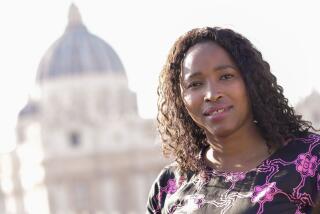Sessions on Gnostic Texts Cool Feminist Scholars’ Enthusiasm
Powerful female figures in the myths of a heretical movement from Christendom’s early centuries began stirring excitement among feminist academicians in the late 1970s when a large cache of such manuscripts were published.
Some of the myths depicted Eve as a rape-eluding heroine in the Garden of Eden. In another, a wife of Noah named Norea burns down the “first” ark with her fiery breath. And the divine emanation, Sophia (the female personification of wisdom), is a major figure in the creation of the world. These were some of the feminine images contained in the 1945 discovery near Nag Hammadi, Egypt.
The collection of more than 50 texts added greatly to scholarly study of the Gnostic movement, a 2nd- and 3rd-Century movement branded as heretical by the orthodox Christian church. Previously, researchers had to rely mostly on descriptions from early Christian leaders--hardly an unbiased source.
Many female religious scholars hoped that these manuscripts might provide valuable images of female divinity or indicate a once-egalitarian society on the fringes of the early church.
But after the first major conference on “Images of the Feminine in Gnosticism,” which began in Claremont last week and concluded Monday in Anaheim, the general assessment was that the imagery is often too abstract, too difficult to relate to actual social situations and--dismaying to feminists--tends to reflect a male-dominated culture among the seemingly “liberated” Gnostics.
“The conference proved to be both heady with excitement and deflating to me,” said Elizabeth Clark of Duke University.
Asked to sum up the conference’s 21 scholarly papers for a concluding panel discussion during the Society of Biblical Literature annual meeting in Anaheim, Clark said her impression was that women scholars could no longer say, “Look at all these female figures in the texts; it must mean that women were doing all sorts of things in Gnosticism.”
Gnosticism was an eclectic movement whose adherents believed that secret knowledge ( gnosis in Greek) of humanity’s beginnings enabled a return to that state even while one was trapped physically in the despicable world. Some Gnostics began claiming to be Christian and presented a competing theology during the first four centuries of Christianity, but they were labeled as heretics starting in the 2nd Century.
One of the most powerful figures in the myths is Sophia--the name is the Greek word for wisdom . In the myths, she is more powerful than the creators of the earth but is regarded as a fallen emanation of the highest god because she tried to procreate without a male partner.
Sophia, commented Paula Fredriksen Landes of UC Berkeley, was “a wandering womb making a mess by herself.”
Some texts go into so much mythological detail about a succession of celestial births that “some writers seemed to be suffering from womb envy,” Landes suggested.
In an analysis of the “Apocryphon (Secret Book) of John,” conference organizer Karen King of Occidental College said, “Deficiency is caused by the female working alone. Salvation comes when male and female work in concert, though always with the male/father in a position more primary than that of the female/mother, both in terms of sequence and in terms of power.”
On the positive side for feminist concerns, King said, the female figures in this and other works are never depicted as passive or weak.
Women Gnostics in some libertine sects may have enjoyed a status equal to men, suggested James E. Goehring, until recently the associate director of the Institute for Antiquity and Christianity in Claremont.
Epiphanius, an early Christian leader who wrote critically about the Gnostics, had claimed that women members of a sect in Alexandria, Egypt, known as the Phibionites, were victims misled by lustful men into sexual orgies and indecent rites.
According to Goehring, Epiphanius described in particular detail a Phibionite rite patterned after the Christian Eucharist in which menstrual blood and male semen were consumed following an orgy. Goehring, who now teaches at Mary Washington College in Virginia, said the ceremony was probably not simply for sexual gratification but reflected Gnostic theology about the seeds of light and truth being present in each human.
Bringing more children into the world furthers the purposes of the evil creator gods, according to a common Gnostic myth, but Goehring said the Phibionite practice short-circuited that process and, in the sect’s view, constituted a sacrifice to the divine.
“The incorporation of the mensus as the blood of Christ alongside the semen as the body of Christ in the Phibionite ritual underscores the positive involvement of the women,” Goehring said. “She, too, contains a part of the divine which must and can be gathered.”
Although scholars have held reservations about the accuracy of the church fathers’ polemical attacks on the Gnostics, Goehring said the consensus is that Epiphanius seemed to have personal knowledge of such a group. A later church father, Augustine, made similar charges against a Gnostic movement that he once followed, Manichaeism.
Goehring also noted that Epiphanius reported the titles of a number of heretical books attributed to female figures, including Norea and Eve. “The number of these books attributed to women or about women is indeed remarkable,” he said.
A dissenting view about the role of women in the Gnostic movements was expressed by Frederick Wisse, one of the translators and interpreters of Nag Hammadi documents and a participant in the concluding panel discussion. In addition to expressing doubts about the significance of the female in Gnostic writings, he also sharply criticized the approaches of some of the scholars at the conference.
“A number of papers were imposing views on the texts from a modern perspective,” Wisse said, calling it “a bad mistake” for feminist scholars to allow their cause to motivate their research. Wisse pleaded for women scholars to be “harder on each other” in their comments and warned them to “be suspicious of males who cheer them on.”
A number of women disputed Wisse’s contention that they were allowing their perspectives to affect their conclusions. Elizabeth Schussler Fiorenza, a leading Catholic feminist scholar, asked: “Why do we have to justify a legitimate category of approach if no one else does?” She cited other academic specialists who “ask questions” traditionally not asked in a given field.
Conference panelists indicated that women scholars will not abandon Gnostic studies fully, even if the writings do not yield ideas or heroines that women can adopt.
If anything, the study of ancient goddesses and contemporary goddess movements appear to be expanding. The goddess figure was subject of several seminar papers at the American Academy of Religion, which met jointly with the Society of Biblical Literature in Anaheim.
“Feminists who are particularly interested in spirituality have a tendency to idealize female images of the divine,” said Diane Jonte-Pace, who teaches psychology of religion at the Catholic-run University of Santa Clara. A danger exists that misogyny, a male hatred of women, may underlie the stories about goddesses, she said.
“I see some women getting involved in goddess rituals,” she said. “Others expand it from the intellectual to the emotional level and feel a sense of mutual support without going any further than that.”


